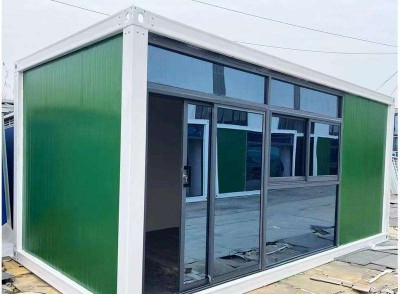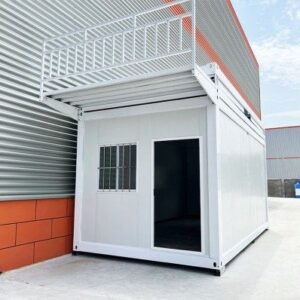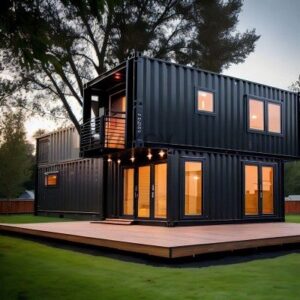The Average Cost to Build a Container House 2025 Figures
When figuring out how much is it to build a container house in 2025, there are a few key price points to keep in mind—from the base container cost to the total construction price per square foot.
Base Price for Shipping Containers
- New containers typically range from $3,000 to $6,000 each depending on size and quality.
- Used containers are usually cheaper, around $1,500 to $3,000, but may require more prep work.
- Renting containers is less common for homes but can cost $100 to $250 per month, which isn’t practical for long-term builds.
Average Build Cost per Square Foot
On average, building a container home—including design, modifications, and finishes—costs about $150 to $300 per square foot.
- This price varies widely based on location, materials, and finishes.
- For comparison, traditional homes often run between $100 and $200 per square foot, so container homes can be competitive, especially with faster build times.
Typical Cost Ranges by Size
| Size | Square Feet | Estimated Total Cost |
|---|---|---|
| Small Home | 200 – 400 | $30,000 – $90,000 |
| Medium Home | 400 – 800 | $60,000 – $180,000 |
| Large Home | 800 – 1,200 | $120,000 – $360,000 |
These ranges cover base container purchase, basic modification, and finishing costs but can increase with customization or site challenges.
Real Project Cost Examples
- A 320 sq ft single-container tiny home in Texas cost around $45,000 fully finished.
- A 640 sq ft two-container modular home in California was completed near $120,000, including permits and utilities hookup.
- A custom 1,000 sq ft multi-container home in Florida had a final budget of about $250,000, reflecting high-end finishes and energy-efficient upgrades.
Understanding these numbers helps set realistic expectations for your container home project based on your budget and goals.
Breakdown of Container House Building Costs
When figuring out how much it costs to build a container house, understanding the detailed cost breakdown is essential. Here’s what typically adds up in your budget:
Container Purchase and Preparation
The container itself is the base cost. Prices vary widely:
- New containers cost more but require less prep.
- Used containers are cheaper but may need repairs and cleaning.
- Renting containers is an option but usually not ideal for permanent homes.
This step also includes modifying the container structure, such as cutting for windows and doors.
Design and Architecture Fees
Custom container house plans require professional design input:
- Architectural drawings that meet code.
- Engineering for structural integrity.
- Modular or multi-container designs raise complexity and fees.
Site Preparation and Foundation
Your build site needs to be ready, which includes:
- Clearing land, leveling, and grading.
- Laying down a foundation suitable for container weight (concrete slab, piers, or footings).
The foundation cost depends on soil, location, and foundation type.
Insulation and Interior Finishing
Containers are metal boxes, so insulation is a must for comfort and energy efficiency:
- Spray foam, rigid foam board, or blanket insulation options.
- Interior wall finishes like drywall, plywood, or paneling.
- Flooring installation including subfloor and final layers.
Plumbing and Electrical Installations
Running utilities inside a container house involves:
- Installing water lines, drainage, and possibly septic hookups.
- Electrical wiring for outlets, lighting, and appliances.
- HVAC systems for heating and cooling.
Windows, Doors, and Framing
Cutouts require new framing for support and finishing:
- Installing energy-efficient windows and doors.
- Adding framing for walls, ceilings, and other structural needs.
Permits and Inspections
Building a container house legally involves:
- Obtaining local building permits and paying associated fees.
- Scheduling inspections during stages of construction to meet code.
Labor Costs DIY Versus Professional Builders
Labor costs can vary dramatically:
- DIY saves money but requires skills and time.
- Professional construction ensures quality but raises costs.
- Many opt for a hybrid approach—DIY for simple tasks and pros for technical work.
Transportation and Delivery of Containers
Getting containers to your site involves:
- Trucking fees depending on distance and site accessibility.
- Equipment to unload and position containers on the foundation.
Additional Costs to Consider Utilities Hookup and Landscaping
Beyond the build itself, budget for:
- Connecting to local utilities (water, electricity, sewage) or setting up off-grid solutions.
- Landscaping, driveways, and exterior finishing touches.
Understanding these cost components gives a clearer picture when planning your container home building budget. For those looking for modular, affordable options check out the modern container house selection or expandable designs for flexible spaces.
The Basics What Is a Container House
A container house is a residential or commercial structure built by converting or stacking shipping containers. These steel containers, originally made for cargo transport, are repurposed into livable spaces offering a modern, modular alternative to traditional building methods.
Types of Container Houses
- Single-container homes: Made from one 20- or 40-foot container, ideal for tiny homes or studios.
- Multi-container homes: Combine several containers side-by-side or stacked to create larger, customizable layouts.
- Modular container homes: Pre-designed, factory-built units that can be quickly assembled onsite, providing flexible and scalable living spaces.
Common Uses and Suitability
Container houses serve various purposes, including:
- Affordable housing solutions
- Vacation cabins or guest houses
- Offices or studios
- Emergency shelters or temporary housing
They are particularly suitable for those seeking quick construction, remote locations, or sustainable housing options.
Advantages Affecting Cost and Value
Several key benefits directly impact the overall cost of building a container house and its appeal:
- Speed of construction: Containers can be quickly delivered and assembled, reducing labor costs and build time.
- Sustainability: Using recycled shipping containers lowers material costs and environmental footprint.
- Modularity: Containers offer flexible designs allowing easy expansions or remodeling.
- Durability: Steel containers are strong, weather-resistant, and secure, minimizing maintenance expenses.
- Cost savings: Compared to traditional homes, container houses often require fewer materials and less building time.
Understanding these fundamentals is crucial when estimating the container house construction price and planning a budget for your project.
Factors Influencing the Cost of a Container House
When figuring out how much it is to build a container house, several key factors can significantly impact your total spend. Understanding these will help you plan realistically and avoid surprises.
Location and Local Regulations
Your location plays a big role in cost. Building codes, zoning laws, and permit fees vary widely across U.S. states and even cities. Some areas have strict requirements for container homes, which can increase design and inspection expenses. Labor rates also differ regionally, with urban centers typically costing more than rural areas.
Container Condition New Versus Used
The choice between new or used containers affects upfront costs. Used containers are cheaper but may require more prep work like rust removal, repairs, or extra insulation. New containers cost more but tend to save you on labor and long-term maintenance. This balance influences the container house construction price directly.
Design Complexity and Customization
Simple, modular container homes cost less than highly customized ones. If you want unique layouts, large windows, or special architectural features, expect higher design fees and construction costs. Complex electrical, plumbing setups, or multi-level builds also add to expenses.
Size and Number of Containers
The total size of your container home naturally affects the price. More containers mean higher costs for purchase, cutting, welding, and joining. Small container homes (one or two units) might start at $30,000 plus finishing, while larger builds with three or more containers often run well above $100,000.
Off-Grid and Sustainable Features
Adding off-grid options like solar panels, rainwater harvesting, or composting toilets increases the budget initially but can lower operating costs long-term. These green elements sometimes require specialized installation, pushing up the build price.
Interior Finishes and Appliances
Your choice of interior materials and appliances can swing costs considerably. High-end flooring, cabinetry, and energy-efficient appliances raise the build price, while budget-friendly finishes help keep the project affordable.
Contractor Experience and Availability
Hiring experienced contractors familiar with container homes often means higher labor rates, but better quality and less rework. In some regions, container home builders are scarce, increasing labor costs and project timelines.
How Container House Costs Compare to Traditional Homes
When looking at cost to build a container home versus a traditional house, the numbers can vary but often show container homes as more affordable upfront. On average, traditional homes in the U.S. range from $150 to $250 per square foot, depending on location and finishes. Container homes typically fall between $100 and $200 per square foot, offering a more budget-friendly option, especially for smaller or modular designs.
Time Savings and Labor Cost Differences
Container homes often require less build time because much of the structure—the steel container—is already in place. Construction can take months off the schedule compared to traditional builds, which helps reduce labor costs significantly. With fewer subcontractors and simplified framing, labor expenses drop, but specialized skills in container modifications might add to costs if not handled by a seasoned professional.
Long-Term Costs Maintenance and Energy Efficiency
In terms of ongoing costs, container houses can offer lower maintenance expenses thanks to durable steel shells that resist pests and weather damage better than wood frames. However, extra care is needed with insulation and rust prevention to avoid future repairs. Energy efficiency can be a strong point if insulation and windows are properly installed, potentially lowering heating and cooling bills compared to standard homes.
Overall, container homes can balance lower initial costs with long-term savings, but success depends on design choices, quality of finishes, and local climate considerations.
Financing and Budgeting Tips for Your Container Home Project
Planning how much it costs to build a container house includes smart financing and budgeting. Here’s how you can approach it effectively.
Financing Options for a Container Home
Unlike traditional mortgages, financing a container home can be a bit different because these are often considered non-conventional builds. Some options include:
- Personal loans or home improvement loans: Easier to get approved but may have higher interest rates.
- Construction loans: Offered by banks for new builds; require detailed plans and budgets.
- FHA or VA loans: Sometimes available if your container home is permanently placed on a foundation and meets local building codes.
- Manufacturer financing: Some container home builders offer financing options directly.
- Cash purchase: Paying upfront saves on loan costs and interest.
Before choosing, check with your local bank or credit unions. Financing rules vary by region, so understanding local lending practices is key.
Budgeting Realistically Based on Your Region
Costs vary widely depending on where you live:
- Labor rates: Higher in urban areas, lower in rural spots.
- Permits and inspections: Some states charge more for container homes.
- Material availability: Shipping container costs and delivery fees depend on proximity to container suppliers.
To budget smartly:
- Research local container home costs to set realistic expectations.
- Include all fees: permits, inspections, utilities hookup, and foundation.
- Plan for cost contingencies—about 10-15% extra for surprises.

Cost-Saving Tips for Building a Container Home
There are ways to lower your total container home construction price without cutting quality:
- DIY some parts: Painting, interior finishes, or landscaping can save thousands.
- Reuse materials: Salvaged wood, recycled insulation, or secondhand windows reduce material costs.
- Simplify design: Fewer containers, standard sizes, and minimal customization keep costs down.
- Choose energy-efficient or modular designs: These can lower long-term utility bills and speed up the build.
Table Financing and Budgeting Tips
| Aspect | Tips |
|---|---|
| Financing | Explore loans, manufacturer financing, or pay cash |
| Regional Budgeting | Adjust for local labor, permits, material availability |
| Contingency Planning | Add 10-15% extra to budget for unexpected costs |
| DIY Strategies | Take on simple tasks yourself to reduce labor costs |
| Material Choices | Use recycled or salvaged materials where possible |
| Design Considerations | Stick to simple container layouts and standard sizes |
For a detailed dive into financing your container home, check out How much is a shipping container house to see the latest tips and regional cost insights.
By planning your budget carefully and exploring flexible financing, you can make your container home dream more affordable and manageable.
Common Hidden Costs in Container House Building and How to Avoid Them
When figuring out how much is it to build a container house, it’s easy to overlook some hidden expenses that can add up quickly. Being prepared for these will save you headaches and extra costs down the line.
Unforeseen Site Issues
Your land might look ready, but issues like poor soil quality, uneven terrain, or underground obstacles can delay construction and drive up costs for:
- Additional site preparation
- Specialized foundation work
- Extra labor or equipment rentals
Avoid this by ordering a thorough land survey and soil test before buying or starting work. Make sure the site is container-home friendly.
Permitting Delays and Fees
Permits are often underestimated in cost and time. Depending on your location, fees and waiting periods for approvals can vary widely.
- Some areas have stricter rules for container homes
- Multiple permits may be needed (zoning, electrical, plumbing, structural)
- Delays can stall your project, increasing labor and rental equipment costs
Tip: Contact your local building authority early to understand all requirements and factor them into your timeline and budget.
Customization Overruns
Container homes can be highly customizable, but every change—like adding skylights, special insulation, or unique layouts—can push your budget beyond initial estimates.
- Custom windows and doors usually cost more
- High-end finishes and fixtures add up
- Unique designs may require skilled labor or special materials
Keep costs down by starting with a simple design and choosing customization options wisely. Prioritize features that add real value and avoid overbuilding.
Transportation Logistics Surprises
Moving heavy containers to your site isn’t always straightforward. Unexpected transportation issues can lead to extra charges:
- Difficult access to your build site may require special equipment
- Permits or escorts might be necessary for oversized loads
- Weather delays can increase haulage costs
To minimize surprises: work with experienced container transporters familiar with your area, and include transportation costs in your overall budget from the start.
Final Checklist Is a Container House Right for Your Budget and Needs
Before you jump into building a container house, it’s important to review key cost factors and match them with your personal needs and budget.
Essential Cost Considerations for Container House Construction
- Container purchase and condition: New containers cost more but need less prep. Used containers are cheaper but might come with hidden repair costs.
- Design complexity: Simple layouts keep costs down. Custom designs with multiple containers, large windows, or unique features add up quickly.
- Location and permits: Local building codes, permit fees, and site prep vary widely and can affect timelines and budgets.
- Labor costs: DIY might save money but can extend the build time. Hiring professionals ensures speed and quality but costs more.
- Interior finishes and utilities: Choices in insulation, plumbing, electrical, and finishes impact the overall price and comfort.
- Additional expenses: Don’t forget site preparation, foundation work, transportation of containers, and landscaping.
Questions to Ask Before Moving Forward
- Does your budget account for all potential expenses, including permits and inspections?
- Are you clear on the size and style you want, and does it fit your local zoning laws?
- How involved do you want to be in the building process? Are you prepared for a DIY project or will you hire a contractor?
- What’s your timeline for completion, and how flexible is it if unexpected costs or delays occur?
- Are sustainable or off-grid features important for your home, and can you afford them upfront?
How yichen Helps with Planning and Building Container Homes
When you’re ready, yichen offers expert guidance tailored to your budget and goals. They help with:
- Accurate cost estimates based on your location and desired home size
- Navigating building permits and local regulations
- Custom design solutions that balance style, function, and cost
- Connecting you with trusted builders and suppliers
- Managing timelines and unexpected cost challenges efficiently
With yichen’s support, you get a clear plan that helps avoid surprises and ensures your container house fits your budget and lifestyle



